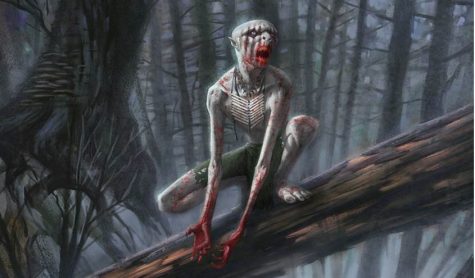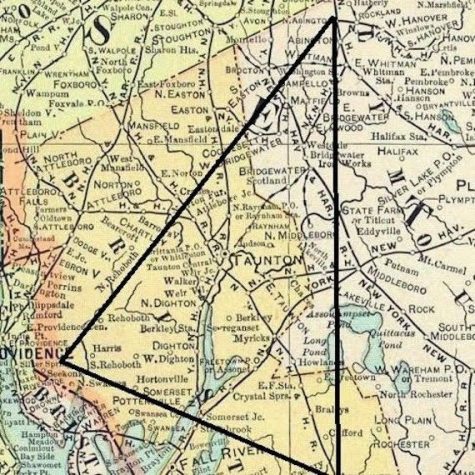Conspiracy Corner – Beast of Burden
October. The spooky season. Leaves change from green to a myriad of earth colors, the air grows colder, and the nights grow longer. For time immemorial, this season has conjured images of witches, ghouls, and a variety of ghosts. From the Celtic Samhain to the modern Halloween, October has always embodied the season of mystery and suspense. It should be no surprise that we here at Conspiracy Corner are big fans of October, especially Halloween. So, this October, we are going on the hunt for a monster – a beast relegated to myth and legend but, for its victims, became horrifyingly real.
This hunt shall take us to Gevaudan, a rural, rustic county in southern France. And though its name has changed to Lozere, there still remains, the rolling ranges of mountain peaks, the lush valleys where peasants of old raised their crops and livestock, and of course, the thick forests unclaimed by man. To this day, many of resident keeps a wary eye on the tree line. For good reason, for they know well the stories of the thing that once emerged from the trees and terrorized all of France. They all know the legend of The Beast.
The story begins in the summer of 1764, with a girl out tending her family’s herd of cattle outside the town of Langogne. Suddenly, a creature came bounding out of the forest and attacked the young woman. It surely would have torn her to shreds if not for the intervention of her cattle. Sensing a predator, the bulls of the herd attacked the beast and frightened it enough for it to flee back into the forest. The young woman reported the incident to her village. She gave the creature the simple yet chilling description of “like a wolf, yet not a wolf”.
Her story, however, was widely ignored. Being so young, the villagers thought that the woman was attacked by a regular wolf, and overcome with shock and fear, imagined it as something far more monstrous. However, they realized their mistake, when bodies started stacking.
Two months later, in June, a 14-year-old girl by the name of Jeanne Boulet was attacked as she watched over a flock of sheep near the village of Ubac. Her body was found badly maimed, seemingly killed by a large wolf. Yet, even still, no one drew connections between the previous attack. Gevaudan was a rural area so attacks by wild animals were not unheard of. Still, the attacks kept coming. Another young girl was killed in Purylaurens, followed by a fourteen-year-old boy outside Langogne in the month of August. The violence increased in the month of September, claiming another four victims. As more people fell dead, the monster seemed to grow bolder. A thirty-six-year-old woman was found murdered right outside her home. All these murders shared a few key elements; the victims were typically young, female, and/or isolated and the only obvious wounds would be to the victims’ neck and head.
In time, the public of Gevaudan began to take note and take action to protect themselves. Governor of the region, Etienne Lafont, became aware of the situation. Being well-connected with the various local authorities, Lafont helped to organize resistance efforts. Predominantly, he arranged for each parish1 to hold “permanent hunts” consisting of small groups of men patrolling the areas. These hunts proved ineffective as most of the locals were not trained hunters and feared tracking the beast without more expert guides.
Enter Jean-Baptiste Duhamel, a captain of a unit of dragoon cavalrymen and an experienced military man. Duhamel took charge of the efforts to find and kill the beast. It should be noted, though, that the issue was a matter of personal pride for the young captain. The French army had suffered defeat in the Seven Years War (French and Indian War, as we know it). The once proud, unstoppable French army was humbled, and its’ soldiers left humiliated. And what better way to heal a bruised ego than hunting a monster?
On October 14th, Lafont ordered all local authorities to assist Duhamel, putting the captain at the head of a massive manhunt. Hundreds of men across Gevaudan were organized to help destroy the Beast. Duhamel attempted a number of methods to destroy the Beast: leading mass hunts of armed men, tracking sightings, and even dressing men as women in hopes of drawing the monster out. However, the efforts proved fruitless. When the Beast was spotted, the hunting parties’ rifles never seemed to fell the creature before it would escape.
As Duhamel pursued in seeming vain, the Beast became the subject of fascination across France and continental Europe. At the time, political news was heavily censored by the Crown – hoping to keep attention away from King Louis’s failings, both economically and diplomatically. Subsequently, the growing French press looked inward for something to write about. This marked the beginning of crime news, with newspapers printing stories of everyday crimes both from the cities and from the countryside. The most popular of these publications was the Courrier d’Avignon, who took up the story of a monster wolf terrorizing rural villages and brought it to national attention.
The papers brought fame not just to the monster, but to those that successfully resisted it. One such case was that of Jacques Portefaix, a young boy who was attacked on January 12th, 1765. He was attacked by the Beast along with his seven friends and, with quick thinking, he rallied his friends, organizing a defense against the creature. By grouping together, and using long sticks like clubs or spears, they managed to drive the Beast off. According to some accounts, the Beast snatched the youngest of Jacque’s friends before retreating to the woods and, in a show of immense courage, Jacque led the others in pursuit of the creature. For their heroics, they managed not only to drive the Beast further away but save their friend, who was only minorly wounded. Not bad for a child reported to be no older than twelve. Jacques’s story reached the Royal Court and was awarded 600 livres by the king himself, who also guaranteed to fund the boy’s education.
So great was the fervor and interest around the Beast, that news reached the king of France, King Louis XVI. It is here that the Beast became a strangely political creature. France was in a state of turmoil. The economy was weakening. It had lost the Seven Year’s War along with many of their North American colonies just ten years prior, and the political tensions between the nobility and the poor would spark the French Revolution in the coming decades. King Louis himself was proving an unpopular ruler, seen as incompetent and, more relevantly, ignorant to the plights of the common people. In the Beast, he saw a chance to unify and strengthen ties with the rural classes. Thus, King Louis ordered that two professional hunters be sent to kill the Beast. These two hunters were Jean-Charles-Marc-Antoine Vaumesle d’Enneval (I shall call him d’Enneval for short from here on) and his son, Jean-Francois.
These two were professionals, having killed over 1,200 wolves over a long, illustrious career. Yet, even they failed to capture the Beast. Whenever they caught news of the monster attacking someone, they would set an ambush for it, only to hear news of it attacking someone else in another location. In time, the two were dismissed and King Louis decided enough was enough. He appointed the task to his personal Gunbearer, the 71-year-old Francois Antoine.
Antoine, when examining the scene of a brutal attack, came to a startling discovery: two sets of wolf tracks. There were two Beasts. A male and female wolf and, supposedly, their pups. Antoine set to work hunting the monster, calling in support from nobles who lent money, manpower, and more importantly, bloodhounds. It was via one of these bloodhound hunts that reported to Antoine that they had discovered the den of a pack of wolves in Pommier Woods. On October 4th, 1765, he led his men into the woods and eventually caught sight of a large wolf, supposedly the male. Using a special type of ammunition, he called “wolf shot”. Antoine readied his rifle. The shot came out like a cannon, toppling Antoine over. But the shot found its mark, riddling with the Beast with shrapnel as well as shredding its right eye. Still, the Beast lived and charged at the defenseless Antoine. But more shots rang out as the hunting party blasted the creature, who died shortly after.
To prove that it was truly the Beast, the wolf was cut open. Inside were the remains of several victims. Yet, the other wolves were not found. So, as the locals celebrated the supposed death of the Beast, Antoine remained vigilant. His wariness was rewarded as his men killed the female wolf after an extensive hunt on October 13th, and the offspring on October 17th. Successful in his task, Antoine had the creatures stuffed and brought to Versailles palace. What has become of those taxidermies, no one knows. How exactly one loses not one but three taxidermies of giant, man-eating wolves, I do not know, but Versailles is a big place after all. Regardless, Antoine was duly rewarded for his ventures with noble titles and not a small cash reward – which the humble Antoine distributed among his retinue of huntsmen. And France rejoiced, for the Beast was finally dead.
Except the attacks kept happening.
In December, the attacks began again. Except now, the Royal Court was convinced that the Beast was dead and would not send support. It fell to the local nobles to handle the situation. Local hunts were organized as peasants were armed and a scattered, desperate defense was hastened together. Enter Jean Chastel. Chastel is a figure clouded in mystery, and frankly, he reads almost like a character out of The Witcher. What is known is that he was a local man, some say a farmer or an innkeeper, and that he was in jail. Some accounts say he was incarcerated due to leading the hunting party into a bog. Yet, others say that he was arrested due to refusing to join the effort to kill the Beast. Supposedly, the refusal was more than just fear. He supposedly claimed that the Beast was no mere animal, no mere wolf. Chastel believed it to be some far, far worse: a werewolf.
Whatever Chastel believed, he supposedly rejoined the hunt in exchange for freedom. What followed is the stuff of legend. Chastel was trekking through the woods when he stopped to pray. As he did, he heard something emerge from the brush. A large, hulking wolf stood before him and yet did not strike. Supposedly, Chastel finished his prayer, calmly loaded the rifle, and fired. And with a single shot, the Beast was struck and fell. The Beast was slain.
One-thousand-eight-hundred words in and I finally get to the speculation part of the article. That only goes to show the epic scale of the Beast of Gevaudan’s story. But even with all that, the lingering question remains: what was the Beast?
The first theory is the simplest: it truly was just an exceptionally large wolf. We know wolves are typically docile creatures but have been known to attack when desperate for food. For example, there is one particularly gruesome incident from 1917 – during the first World War – where Russian and German troops were forced to make a ceasefire to fend off a large pack of starving wolves that had started to attack them. Fifty wolves were slain before the pack retreated. To further this, Gevaudan itself was no stranger to wolf attacks. Historian Jean-Marc Moriceau, claims that in the period between the 16th and 17th centuries, over 9,000 French people had been killed by starving wolves.
You may say that the Beast was said to be impervious to bullets, according to the words of those that hunted it. Yet, one must remember that early on, these hunting parties were comprised predominantly of peasants. Most of them were too poor to own rifles and, except for a few expert hunters and those with military service, the majority of them likely had never held a firearm in their lives before these hunts. Add on that 18th-century muskets were already far from accurate, and you can see that the Beast may not have been enduring the shots but, rather, the bullets were missing. Perhaps the animal killed by Jean Chastil was nothing more than a pup that managed to escape its pack’s killing?
Others claim that the Beast was actually an exotic animal. One newspaper described the Beast as “reddish-brown with a dark ridged stripe down the back… Long, gaping jaw, six claws, pointy upright ears, and supple tail…”. With that description in mind, could it be possible that the Beast was an African hyena?
The claim seems far-fetched but consider this: it was in vogue for French nobles to host menageries. Collecting animals from far-off countries was a sign of wealth and status. But, as anyone who’s heard of Chicago’s rumored sewer gators or Florida’s very real chimp attacks (It’s a real thing, look it up!) can attest, when exotic animals escape captivity, things can go bad quick. If a hyena did escape a zoo or personal collection, it would find an almost unchallenged food supply in the providence’s livestock and their herders. With a steady supply of food and no natural predators, an escaped hyena pack could grow to immense size. Evidence of this theory is found in the aforementioned newspaper article, which describes the Beast’s cry as “more like a horse neighing than a wolf howling.” Perhaps what they heard wasn’t a horse neighing but a hyena laughing?
The strange thing, though, is that the Beast did not act like a regular animal in most of the reports. Survivors always noted that the Beast came after them directly, ignoring the animals. Further, even when the Beast claims a victim and kills someone, it often left the animals unharmed. As far as my research can show, the Beast only resorted to hunting animals after being wounded by Antoine. Thus, what if the Beast was a kind of animal that favored the taste of human?
Enter our third theory which is, of course, the most fantastical. What if the Beast of Gevaudan was, in fact, a werewolf? That would certainly explain the Beast’s supposed resistance to firearms. Note that Jean Chastel was the only one to slay one of these creatures with a single shot. And legend says, that fearing the Beast to be just such a monster, Chastel brought with him a special weapon: a bullet made of silver.
One may object to this theory because, if nothing else, the killings do not line up with the lunar cycle. Yet, in folklore from the time, a full moon was not always necessary for a werewolf to transform. Often, in historical cases of “real” werewolves, the person accused of being a wolfman would testify that the power of lycanthropy was given to them by a mysterious, otherworldly force – usually a demon or the Devil. One such example would be Pierre Burgot and Michel Verdun, a pair of French men who, in 1521, confessed to murdering children. The men claimed that the Devil gave them an ointment that could shape them into something half-man and half-wolf. The Inquisition had them both burned at the stake.
Yet, what if the Beast of Gevaudan was a beast of another variety? After all, what kind of monster targets only women and children, can hide effortlessly from search parties, and ignores animals? The human kind. What if the Beast was a serial killer acting under the pretense of being a werewolf? Sounds like the plot of a Scooby-Doo episode with an R rating, but such a thing has historical precedent. Consider the case of one Gilles Garnier. Garnier was a Frenchman who, in 1573, was arrested after being caught with the body of a dead child. He later confessed to four murders where he would kill children and eat parts of their bodies. He never used a weapon but instead attacked his victims savagely, clawing at them or biting. In one particularly gruesome case, he tore a small boy in half by eating through his midriff. Just like Burgot and Verdun mentioned before, he was burned at the stake.
Pair that with the story of Peter Stubbe, a German farmer in the late 1500’s. He supposedly was captured after hunters cornered a large wolf, only to find Peter in its place, in a cloak made of wolf-skin. Under torture, he claimed to have been granted a belt from the Devil, which allowed him to turn into a wolf to commit crimes. These crimes included murdering women, children, and even his own son. His daughter was accused of being both his accomplice and his mistress (ew). Both of them were executed on October 31st, 1589, in one of Germany’s most gruesome executions, including public torture with red hot pokers and flaying followed by Peter’s beheading and his daughter’s strangulation. However, the accuracy of Peter’s guilt is questionable as many people believe his accusation to do more with politics than any lycanthropy. Given that this occurred during the Thirty Years War where accusations of witchcraft and lycanthropy were easy ways to get rid of political opponents, it seems Peter and his daughter may have been the victims instead of killers.
Remember that the Beast was remarked to attack mostly the neck or head. This aligns with a more recent serial killer named Fritz Haarmann, known, fittingly, as “The Werewolf”. Haarmann was another German serial killer whose preferred method of killing was tearing the throats of his victims out with his teeth. He killed twenty-four people before being tried and executed in 1924. By beheading! With a guillotine! I didn’t know they still used that in the 1920s!
In the end, all we know is that for three long years, all of France lived in fear of the Beast. Though the newspapers and public hysteria may have made the Beast of Gevaudan more myth than reality, we cannot forget that the creature was very much real. Real enough to have taken the lives of one-hundred-thirteen people. And that hint of truth, that undeniably real horror of the Beast, is what gives the story its potency. The Beast becomes more than some far-off legend or easily dismissed werewolf story, but something tangible enough to leave behind bodies. It is the root of reality from which the werewolf myth grows, elevating superstition into the realm of possibility. So next time you are out after dark and a full moon brightens the night sky, maybe you should walk a bit faster and listen for the sounds of howls in the darkness. Because, if the Beast of Gevaudan was real, who knows what else is?







